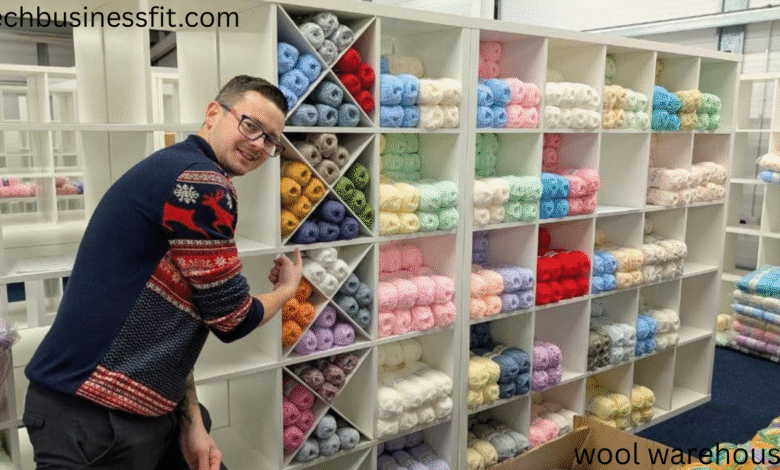Here’s a full-length, keyword-rich, detailed article draft for “wool warehouse” with headings, subheadings, and natural keyword use (1000–1200+ words).

Wool warehouse is a term that sparks excitement for knitters, crocheters, crafters, and textile lovers alike. It is more than just a storage facility for wool – it represents a hub where creativity meets raw materials, a place where knitting yarns, crochet threads, fabrics, and craft essentials are stored, organized, and distributed. For many, wool warehouse serves as the foundation of their crafting journey, whether they are hobbyists making scarves at home or professionals creating garments for global markets.
The concept of wool warehouse has existed for centuries, evolving from simple storage barns to large modern hubs that cater to both individual customers and wholesale businesses. Today, the term “wool warehouse” is synonymous with accessibility, variety, and quality in the crafting world.
The Role of Wool Warehouse in the Crafting Community
One of the most important aspects of wool warehouse is its ability to bring together an incredible selection of yarns, fibers, and accessories under one roof. For crafters, this means no longer relying on small local shops with limited stock. Instead, wool warehouse provides access to countless options – from luxury alpaca blends to budget-friendly acrylics, from vibrant color palettes to muted earthy tones.
For knitting and crochet enthusiasts, wool warehouse often becomes the first stop when planning a new project. Having a reliable wool warehouse ensures that projects can start without delays, and materials can be sourced quickly. This accessibility inspires creativity and ensures that crafters can keep up with trends in yarn crafts, seasonal projects, and fashion influences.
Wool Warehouse and the Evolution of Yarn Choices
Decades ago, wool warehouse mainly stored natural sheep’s wool in different grades. Today, however, the story is different. A modern wool warehouse offers a vast selection of fibers including:
- Natural fibers: Wool, alpaca, mohair, cotton, silk, bamboo.
- Synthetic fibers: Acrylic, nylon, polyester blends.
- Specialty yarns: Hand-dyed skeins, eco-friendly yarns, chunky wool for arm knitting.
This evolution has transformed wool warehouse into a hub not only for traditional knitters but also for modern makers experimenting with sustainable fashion, DIY crafts, and fiber art.
The Importance of Wool Warehouse for Beginners and Professionals
Whether you are a beginner or a seasoned expert, wool warehouse plays a crucial role.
- For beginners: Having a one-stop shop for all supplies makes it easier to get started. Starter kits, affordable yarn packs, and easy-to-follow patterns are usually available in a wool warehouse, reducing the barriers to entry into knitting or crochet.
- For professionals: Designers, teachers, and artisans depend on wool warehouse to source high-quality yarns in bulk. This ensures consistent supply and variety to meet the needs of their clients or students.
Thus, wool warehouse acts as a bridge between creativity and practicality.
Wool Warehouse as a Source of Inspiration
Walking into or browsing a wool warehouse often feels like stepping into a world of endless possibilities. The vibrant rows of yarns, the textures of different fibers, and the accessories like needles, hooks, and looms all spark creative ideas. Many crafters describe wool warehouse as more than just a supply store – it is a space of inspiration.
Additionally, seasonal themes and curated collections inside a wool warehouse help crafters decide on their next project. For example, in winter, chunky wools and neutral tones may be highlighted, while in spring, cotton yarns and pastel colors take center stage.
Organization and Management in Wool Warehouse
Behind the scenes, managing a wool warehouse requires careful planning and organization. Yarn is delicate and must be stored under specific conditions to maintain its quality. Factors like humidity, temperature, and cleanliness play a role. Wool warehouse managers must also categorize yarns by weight, fiber type, brand, and color.
The efficiency of a wool warehouse directly affects the customer experience. A well-organized warehouse ensures that orders are fulfilled quickly, whether they are wholesale shipments or individual skeins sent to a home crafter. Modern wool warehouses often rely on inventory management software to track stock and maintain consistent supply.
Wool Warehouse and Sustainable Crafting
In today’s world, sustainability is an essential part of every industry, and wool warehouse is no exception. Many wool warehouses now stock eco-friendly yarns, organic cottons, and recycled fibers. They also emphasize natural dyes and biodegradable packaging.
Sustainability in wool warehouse operations goes beyond products. Energy-efficient storage, ethical sourcing, and partnerships with fair-trade suppliers are becoming more common. By choosing products from a sustainable wool warehouse, crafters contribute to reducing environmental impact while supporting ethical practices.
The Global Reach of Wool Warehouse
Wool warehouse is not limited to one region or country. Yarn enthusiasts worldwide rely on both physical and online wool warehouse services to access their favorite fibers. International shipping, digital catalogs, and global collaborations have made wool warehouse a universal concept.
For many small businesses and indie yarn dyers, partnering with a wool warehouse allows their products to reach a larger audience. In this way, wool warehouse serves as a global marketplace for creativity and craftsmanship.
Wool Warehouse and the Rise of Online Communities
Alongside physical storage and distribution, wool warehouse has become a central theme in online crafting communities. Social media groups, forums, and video tutorials often feature yarn hauls and unboxings from wool warehouses. These communities share project ideas, review products, and recommend yarns sourced from wool warehouses.
This digital connection further enhances the reputation of wool warehouse, making it not just a physical space but also a cultural phenomenon in the crafting world.
Future Trends in Wool Warehouse
As crafting continues to gain popularity, wool warehouse will evolve in new and exciting ways. Some future trends may include:
- Smart inventory systems powered by AI to predict customer needs.
- Virtual reality browsing where customers can explore wool warehouse shelves online.
- Customized yarn dyeing services directly offered by wool warehouse.
- Workshops and maker spaces connected to wool warehouses, turning them into creative hubs.
These innovations will ensure that wool warehouse remains relevant in the fast-changing world of craft and fashion.
Conclusion: Why Wool Warehouse Matters
At its core, wool warehouse represents much more than a place to store yarn. It is a symbol of creativity, community, and craft. From beginners starting their first scarf to professionals producing large collections, everyone finds value in wool warehouse. Its role in preserving traditions, embracing innovation, and inspiring makers ensures that it will remain a cornerstone of the crafting world for generations to come.


